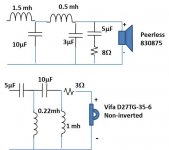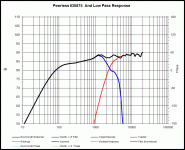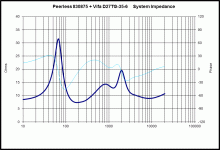Hi,
I can't find FA recommending it as a T27 alternative.
It certainly isn't a drop-in replacement and I find WA's
recommendation hard to fathom, it isn't the same size.
The 108mm diameter is unusually large for a 19mm tweeter.
For DIY the Celestion HF2000 equivalent is much closer to a T27 :
Seas 19TFF1 H0737-08 Tweeter - Celestion HF2000 replacement
94mm though, most 1" domes are 100mm.
rgds, sreten.
Hi, I can no longer find the statement that the Vifa D27TG-35-06 is a suitable T27 substitue either. The references to it all disappeared. It used to appears at the page of "FALCON LS3/5a STYLE MINI-MONITOR" and the Vifa D27TG-35-06 product page.
Willslow usually just follow the lead of Falcon. Falcon apparently had a change of mind, but forget to tell Willslow. 🙄
Hi, I can no longer find the statement that the Vifa D27TG-35-06 is a suitable T27 substitue either. The references to it all disappeared. It used to appears at the page of "FALCON LS3/5a STYLE MINI-MONITOR" and the Vifa D27TG-35-06 product page.
Willslow usually just follow the lead of Falcon. Falcon apparently had a change of mind, but forget to tell Willslow. 🙄
Hi,
I can't find the FA statement that a 28mm Morel is a
T27 replacement either. The only thing in common is
a 104mm faceplate, better than 100mm for 108mm.
rgds, sreten.
Can't vouch for it as a replacement for the kef, but there's no doubt it's a fine quality tweeter. See zaph. Also used by all the original PMC designs, before they switched to seas.
Should also mention I have a pair if you want any particular measurements or subjective opinions
Hylle, thank you for the update.
I do not have any inside scope about Tymphany or ScanSpeak. I just did a direct quote from the Tymphany website. According to Tymphany, they now own the ScanSpeak brand. Is it true or not true? What is the relationship of the company in Videbaek to Tymphany?
ScanSpeak was acquired by "KYET" in 2014:
Scan-Speak press release
I googled Tymphany to try and find that ScanSpeak reference you mentioned but all I found was "Scan-Peek" in their website description 🙂
ScanSpeak was acquired by "KYET" in 2014:
Scan-Speak press release
I googled Tymphany to try and find that ScanSpeak reference you mentioned but all I found was "Scan-Peek" in their website description 🙂
Does it really matter which Hong Kong or Taiwan company owns the Scan-speak brand? They changed hand so rapidly that it is impossible to keep track with.
KYET at one time owns the Tymphany, but diversed it to get capital for other business. It will not be surprise that KYET acquired Scan-speak from Tymphany and Tymphany did not update their website. It may also be possible that someone already bought Scan-speak from Tymphany and later sold it to KYET.
Before their acquisition by KYET, Scan-speak launched their "Discovery" line of product in 2009. The Scan-speak Discovery product are mostly copy of Vifa and are being sold at lower price than other Scan-speak.
If anyone is interested in the history of the Danish loudspeaker industry, this a wonderful web book for it.
http://www.cfuttrup.com/history/index.html
If you find the "Scan-Peek" and enjoy it. Wonderful. It is NOT the purpose of this thread. 🙄
Last edited:
Enjoyed reading that, keilau! 🙂
History Book of the Danish Loudspeaker Industry
Hints of financial skullduggery in these smallish companies. Which is a shame, because a lot of us do this stuff for the love of it really. I wonder if SEAS will regret selling out?
Those big voicecoil dynaudio/morel 6" polycone units which need hardly any filtering.
The SS D2008 which morphed into hiquphon 19mm tweeter units IIRC.
Then the famous D2905 series of 1" tweeters.
Last but not least the SS D3806 1.5" tweeter designed to replace that SEAS H086 unit in the Dynaco A25. SP38/13
A lot of copper damping rings going into these top class units. But I was reminded of something I'd nearly forgotten. You really shouldn't use a 3/4" tweeter much below 3kHz. 1" around 2.2kHz, and for a Dynaco A25 clone you need something very special that won't distort below 1500Hz. And you help your cause with steeper filters when you push drivers hard.
Which is to say, the KEF T27 was probably pushed to its limits anyway!
History Book of the Danish Loudspeaker Industry
Hints of financial skullduggery in these smallish companies. Which is a shame, because a lot of us do this stuff for the love of it really. I wonder if SEAS will regret selling out?
Those big voicecoil dynaudio/morel 6" polycone units which need hardly any filtering.
The SS D2008 which morphed into hiquphon 19mm tweeter units IIRC.
Then the famous D2905 series of 1" tweeters.
Last but not least the SS D3806 1.5" tweeter designed to replace that SEAS H086 unit in the Dynaco A25. SP38/13
A lot of copper damping rings going into these top class units. But I was reminded of something I'd nearly forgotten. You really shouldn't use a 3/4" tweeter much below 3kHz. 1" around 2.2kHz, and for a Dynaco A25 clone you need something very special that won't distort below 1500Hz. And you help your cause with steeper filters when you push drivers hard.
Which is to say, the KEF T27 was probably pushed to its limits anyway!
Enjoyed reading that, keilau! 🙂
History Book of the Danish Loudspeaker Industry
Hints of financial skullduggery in these smallish companies. Which is a shame, because a lot of us do this stuff for the love of it really. I wonder if SEAS will regret selling out?
We are quoteing the same web page.
Those big voicecoil dynaudio/morel 6" polycone units which need hardly any filtering.
The SS D2008 which morphed into hiquphon 19mm tweeter units IIRC.
Then the famous D2905 series of 1" tweeters.
Last but not least the SS D3806 1.5" tweeter designed to replace that SEAS H086 unit in the Dynaco A25. SP38/13
A lot of copper damping rings going into these top class units. But I was reminded of something I'd nearly forgotten. You really shouldn't use a 3/4" tweeter much below 3kHz. 1" around 2.2kHz, and for a Dynaco A25 clone you need something very special that won't distort below 1500Hz. And you help your cause with steeper filters when you push drivers hard.
Which is to say, the KEF T27 was probably pushed to its limits anyway!
I have a pair of the Audax HD12x9D25 and the Seas H107, both of which were supposed to be on top of their game in the 1970's. They still sound very good to me, but their design calls for crossover frequency in the 3K region. The newer Vifa D27TG-35-06 can go much lower. Thus, making it easier to crossover with the Peerless HDS 830875. The cabinet is the 15 litres closed box.
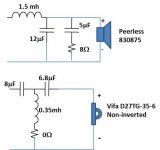
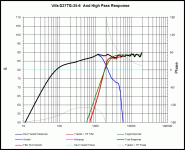
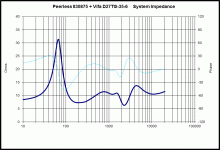
I have not done the listening test yet. But I suspect that the Vifa will win over the Audax.
Last edited:
Of course we are quoting the same web page. I always try to make myself clear.
I think you're making a mistake crossing over low here. Lojzek used 2.7kHz LR4, even if he's a bit short (as usual...🙄 ) on detail:
http://www.diyaudio.com/forums/multi-way/23208-system-pictures-description-257.html#post3993609
[RANT] What is about this forum that people are so secretive about circuits? They think they are World-beaters or something? It's all simple physics! [/RANT]
[RANT]Continuing my theme, here's our own lovely Joe Rasmussen indulging in some serious DIYAudioFoolery with his Elsinores.[/RANT]
The Renegade Tweeter Theory
I mean we all know that 12dB/octave LR2 is a negative polarity solution when time aligned with a waveguide. Not hard, is it? Hardly RENEGADE.
Good luck with this. I'm sure you can adapt it if it doesn't work right first time. That's what I do! 😀
I think you're making a mistake crossing over low here. Lojzek used 2.7kHz LR4, even if he's a bit short (as usual...🙄 ) on detail:
http://www.diyaudio.com/forums/multi-way/23208-system-pictures-description-257.html#post3993609
[RANT] What is about this forum that people are so secretive about circuits? They think they are World-beaters or something? It's all simple physics! [/RANT]
[RANT]Continuing my theme, here's our own lovely Joe Rasmussen indulging in some serious DIYAudioFoolery with his Elsinores.[/RANT]
The Renegade Tweeter Theory
I mean we all know that 12dB/octave LR2 is a negative polarity solution when time aligned with a waveguide. Not hard, is it? Hardly RENEGADE.

Good luck with this. I'm sure you can adapt it if it doesn't work right first time. That's what I do! 😀
Of course we are quoting the same web page. I always try to make myself clear.
I think you're making a mistake crossing over low here. Lojzek used 2.7kHz LR4, even if he's a bit short (as usual...🙄 ) on detail:
http://www.diyaudio.com/forums/multi-way/23208-system-pictures-description-257.html#post3993609
[RANT] What is about this forum that people are so secretive about circuits? They think they are World-beaters or something? It's all simple physics! [/RANT]
[RANT]Continuing my theme, here's our own lovely Joe Rasmussen indulging in some serious DIYAudioFoolery with his Elsinores.[/RANT]
The Renegade Tweeter Theory
I mean we all know that 12dB/octave LR2 is a negative polarity solution when time aligned with a waveguide. Not hard, is it? Hardly RENEGADE.
Good luck with this. I'm sure you can adapt it if it doesn't work right first time. That's what I do! 😀
Steve, thank you for the reference and the encouraging words.
I ran into problem smoothing the woofer if I crossover higher as you see in my Peerless-Audax response curve.
Lojzek used practically the same driver set as I picked. I wonder how he chose what he did. These are mid range price in the $50-80 USD range each which met my budget and performance objective.
It's all simple physics!
Really?! But why the FR chart above looks so awful? FR is not everything, yes, but...

Really?! But why the FR chart above looks so awful? FR is not everything, yes, but...
What frequency response chart are you referring to? The two that I posted is as good as any that I had seen using simulation software. If you are referring to the charts I posted, would you be more specific about what is "so awful" about them?
I posted the curve with the baffler diffraction of a small bookshelf accounted for. I suspect that you are not used to it and expect to see the woofer to act as if it is mounted on a infinite baffler. I used Jeff Bagby's "The Frequency Response Modeler" to account for the box diffraction effect. If you find any problem with his approach, please, let me know. We all know that the real response will be different in with real room boundaries.
Loudspeaker Design Software
The crossover was also modeled with Jeff's PCD program. He recommend that the baffler diffraction be accounted for before the crossover design.
Paul Carmody has a very nice writie-up about how this process work.
https://sites.google.com/site/undefinition/simulated-measurements
The Bagby/Carmody process may not work perfectly, but it works for many hobbyist. It is mean spirited to call something "so awful" without sharing your process and results.
I used to use these in the '90s, I think this is how I remember them. One of the better Vifas. No metallic sound like the D25 but not as good in other ways.they have a certain raspiness to them, which is not bad, but there.
The Bagby/Carmody process may not work perfectly, but it works for many hobbyist. It is mean spirited to call something "so awful" without sharing your process and results.
Sorry, I was just trying to say that, yes, Physics is easy, but may be not. It is probably the hardest subject in the world. Speaker design particularly is not as easy as it looks like, imo.
I'm not trying to say that your work is not good enough, but I want you to realize that there is actually learning curve...
The good thing about software is that they have optimization algorithm. You can draw any curve, construct a necessary crossover structure and let the software to calculate the values for the R, L and C...
Smooth roll-off curve is important because they determine phase response...
Jay
Have you actually done anything with a Vifa D27tg ?
Yes, but I didn't like this tweeter. May be I didn't know how to use it but I had more success with D26 and XT25.
Unfortunately I didn't know about the ATC SCM20 using the tweeter. If I did, I would try the filter AND especially the waveguide. It's strange how such a tweeter (that I think is not good) is used by ATC. But I think the tweeter can accept SPL abuse, just like the woofer in the ATC.
That's right, I had the 45s with the lips, is that what you mean by the waveguide? Don't bother if it is.
These were respected tweeters once (in ordinary circles, that is).
These were respected tweeters once (in ordinary circles, that is).
That's right, I had the 45s with the lips, is that what you mean by the waveguide? Don't bother if it is.
These were respected tweeters once (in ordinary circles, that is).
Yes. The OP is (considering) using the 35, which I have never liked.
- Home
- Loudspeakers
- Multi-Way
- How good is Vifa D27TG-35-6
